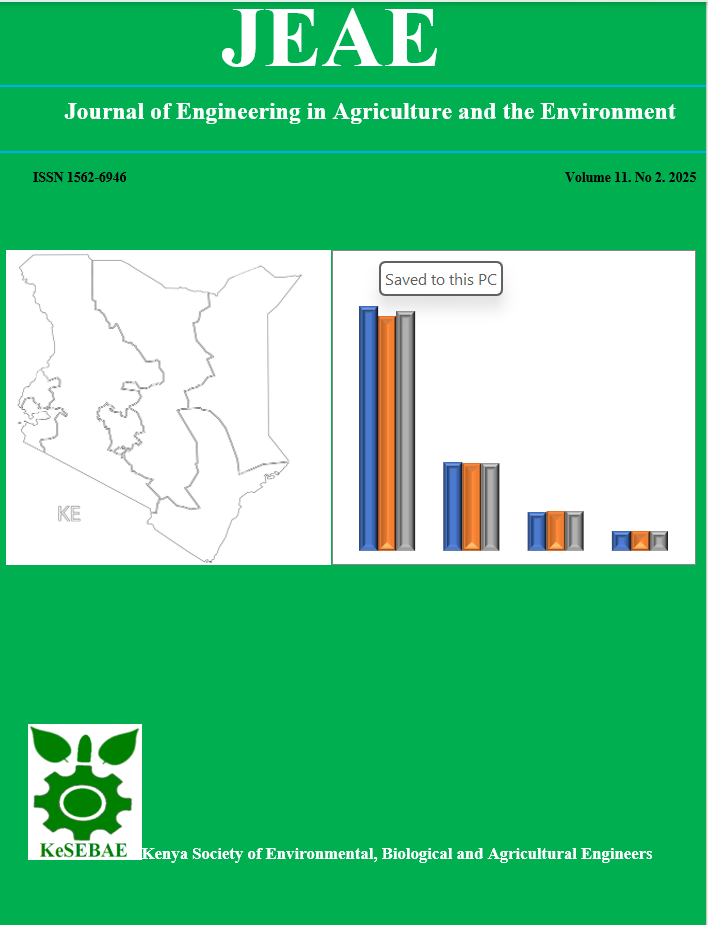Abstract
Sensor-based characterization of soil properties is inevitable due to the tedious, expensive, and time-consuming nature of traditional laboratory-based soil testing. This study focused on characterizing the soil properties of Indian Sundarban at depths of 0cm–20cm, 20cm–50cm, and 50cm–100cm using a PXRF, a Nix Pro color sensor, and a USB soil microscope. The soil samples belonged to mudflats in the intertidal zone and abandoned shrimp ponds. The soil samples were analyzed via Wet Digestion and Dry combustion for organic carbon (OC), total carbon (TC), and bulk density (BD). The average OC, TC, and BD at 0cm–20cm were 7.69 t/ha, 8.74 t/ha, and 1150 kg/m3, respectively. At 20cm–50cm, it was 11.73 t/ha, 13.08 t/ha, and 1239 kg/m3, respectively; 17.733 t/ha, 20.083 t/ha, and 1196 kg/m3, respectively, at 50cm–100cm. Modeling of OC, TC, and BD via multiple linear regressions was validated using R2 and RMSE. PXRF produced satisfactory results, with BD (R2 = 0.928; 0.9431; 0.998), SOC (R2 = 0.9785; 0.9297; 0.9726), and TC (R2 = 0.9938; 0.9619; 0.987). The Nix Pro color sensor with RGB, CIEL*A*b, and CMYK color spaces BD (R2 = 0.3769; 0.4786; 0.3894), SOC (R2 = 0.649; 0.3029; 0.4314), and TC (R2 = 0.4932; 0.2603; 0.5518). USB microscope with RGB color space underperformed, while similar performance sequence was observed using RMSE. Also, soil data was spatially analyzed to assess variability across three depths.
References
Akther, S. M., Islam, M. M., Hossain, M. F., & Parveen, Z. (2021). Fractionation of Organic Carbon and Stock Measurement in the Sundarbans Mangrove Soils of Bangladesh. American Journal of Climate Change, 10(4), Article 4. https://doi.org/10.4236/ajcc.2021.104028
Bakshi, M., Ram, S. S., Ghosh, S., Chakraborty, A., Sudarshan, M., & Chaudhuri, P. (2017). Micro-spatial variation of elemental distribution in estuarine sediment and their accumulation in mangroves of Indian Sundarban. Environmental Monitoring and Assessment, 189(5), 221. https://doi.org/10.1007/s10661-017-5891-9
Bhattacharyya, T., Chandran, P., Ray, S. K., Mandal, C., Tiwary, P., Pal, D. K., Maurya, U. K., Nimkar, A. M., Kuchankar, H., Sheikh, S., Telpande, B. A., & Kolhe, A. (2015). Walkley-Black Recovery Factor to Reassess Soil Organic Matter: Indo-Gangetic Plains and Black Soil Region of India Case Studies. Communications in Soil Science and Plant Analysis, 46(20), 2628–2648. https://doi.org/10.1080/00103624.2015.1089265
Bhunia, G. S., Shit, P. K., & Maiti, R. (2016). Soil organic carbon stock explored by geo-spatial modeling at Sagar Island, India. Spatial Information Research, 24(5), 503–514. https://doi.org/10.1007/s41324-016-0048-4
Blanco-Canqui, H., & Lal, R. (2008). Soil and Water Conservation. In H. Blanco-Canqui & R. Lal (Eds.), Principles of Soil Conservation and Management (pp. 1–19). Springer Netherlands. https://doi.org/10.1007/978-1-4020-8709-7_1
Dexter, A. R. (2004). Soil physical quality: Part I. Theory, effects of soil texture, density, and organic matter, and effects on root growth. Geoderma, 120(3), 201–214. https://doi.org/10.1016/j.geoderma.2003.09.004
Dey, P., Karwariya, S., & Bhogal, N. S. (2017). Spatial Variability Analysis of Soil Properties Using Geospatial Technique in Katni District of Madhya Pradesh, India. International Journal of Plant & Soil Science, 17, 1–13. https://doi.org/10.9734/IJPSS/2017/34219
Duda, B. M., Weindorf, D. C., Chakraborty, S., Li, B., Man, T., Paulette, L., & Deb, S. (2017). Soil characterization across catenas via advanced proximal sensors. Geoderma, 298, 78–91. https://doi.org/10.1016/j.geoderma.2017.03.017
Enang, R. K., Yerima, B. P. K., Kome, G. K., & Van Ranst, E. (2018). Assessing the Effectiveness of the Walkley-Black Method for Soil Organic Carbon Determination in Tephra Soils of Cameroon. Communications in Soil Science and Plant Analysis, 49(19), 2379–2386. https://doi.org/10.1080/00103624.2018.1510948
Franzese, M., & Iuliano, A. (2018). Correlation analysis. Elsevier. https://doi.org/10.1016/B978-0-12-809633-8.20358-0
Gogtay, N., & Thatte, U. (n.d.). Principles of Correlation Analysis.
How IDW works—ArcGIS Pro | Documentation. (n.d.). Retrieved January 29, 2024, from https://pro.arcgis.com/en/pro-app/latest/tool-reference/3d-analyst/how-idw-works.htm
John, K., Kebonye, N. M., Agyeman, P. C., & Ahado, S. K. (2021). Comparison of Cubist models for soil organic carbon prediction via portable XRF measured data. Environmental Monitoring and Assessment, 193(4), 197. https://doi.org/10.1007/s10661-021-08946-x
Kingsley, J., Lawani, S. O., Esther, A. O., Ndiye, K. M., Sunday, O. J., & Penížek, V. (2019). Predictive Mapping of Soil Properties for Precision Agriculture Using Geographic Information System (GIS) Based Geostatistics Models. Modern Applied Science, 13(10), 60. https://doi.org/10.5539/mas.v13n10p60
Mikhailova, E. A., Stiglitz, R. Y., Post, C. J., Schlautman, M. A., Sharp, J. L., & Gerard, P. D. (2017). Predicting Soil Organic Carbon and Total Nitrogen in the Russian Chernozem from Depth and Wireless Color Sensor Measurements. Eurasian Soil Science, 50(12), 1414–1419. https://doi.org/10.1134/S106422931713004X
Mukhopadhyay, S., & Chakraborty, S. (2020). Use of diffuse reflectance spectroscopy and Nix pro color sensor in combination for rapid prediction of soil organic carbon. Computers and Electronics in Agriculture, 176, 105630. https://doi.org/10.1016/j.compag.2020.105630
Rahman, Md. S., Donoghue, D. N. M., & Bracken, L. J. (2021). Is soil organic carbon underestimated in the largest mangrove forest ecosystems? Evidence from the Bangladesh Sundarbans. CATENA, 200, 105159. https://doi.org/10.1016/j.catena.2021.105159
Sreelekshmi, S., Nandan, S. B., Kaimal, S. V., Radhakrishnan, C. K., & Suresh, V. R. (2020). Mangrove species diversity, stand structure and zonation pattern in relation to environmental factors—A case study at Sundarban delta, east coast of India. Regional Studies in Marine Science, 35, 101111. https://doi.org/10.1016/j.rsma.2020.101111
Sudarsan, B., Ji, W., Biswas, A., & Adamchuk, V. (2016). Microscope-based computer vision to characterize soil texture and soil organic matter. Biosystems Engineering, 152, 41–50. https://doi.org/10.1016/j.biosystemseng.2016.06.006
Swetha, R. K., Mukhopadhyay, S., & Chakraborty, S. (2020). Advancement in Soil Testing with New Age Sensors: Indian Perspective. In A. Rakshit, S. Ghosh, S. Chakraborty, V. Philip, & A. Datta (Eds.), Soil Analysis: Recent Trends and Applications (pp. 55–68). Springer. https://doi.org/10.1007/978-981-15-2039-6_4
Viscarra Rossel, R. A., Adamchuk, V. I., Sudduth, K. A., McKenzie, N. J., & Lobsey, C. (2011). Chapter Five - Proximal Soil Sensing: An Effective Approach for Soil Measurements in Space and Time. In D. L. Sparks (Ed.), Advances in Agronomy (Vol. 113, pp. 243–291). Academic Press. https://doi.org/10.1016/B978-0-12-386473-4.00005-1
Wang, D., Chakraborty, S., Weindorf, D. C., Li, B., Sharma, A., Paul, S., & Ali, Md. N. (2015). Synthesized use of VisNIR DRS and PXRF for soil characterization: Total carbon and total nitrogen. Geoderma, 243–244, 157–167. https://doi.org/10.1016/j.geoderma.2014.12.011

This work is licensed under a Creative Commons Attribution 4.0 International License.
Copyright (c) 2025 S. Chakraborty, E.W. Mutayi
